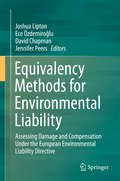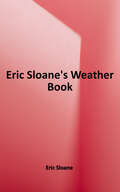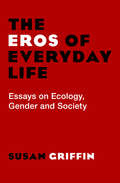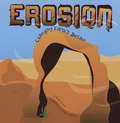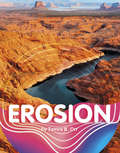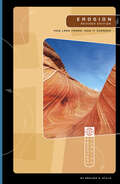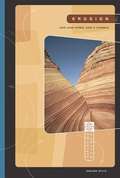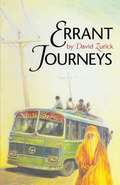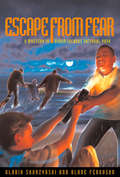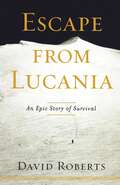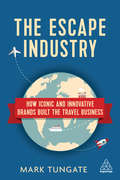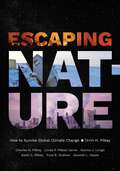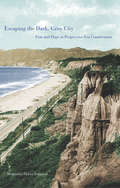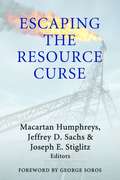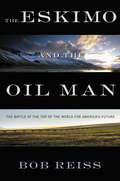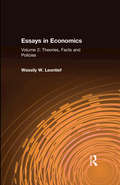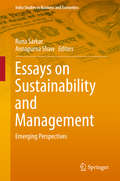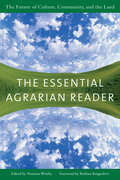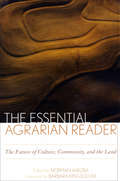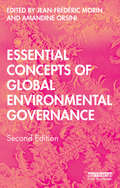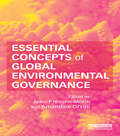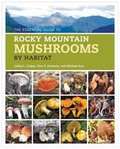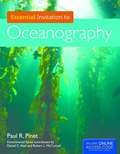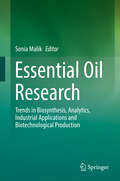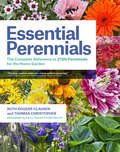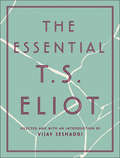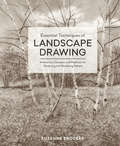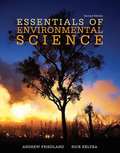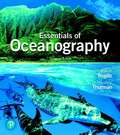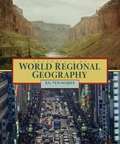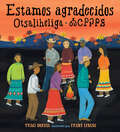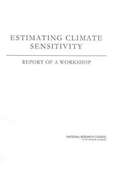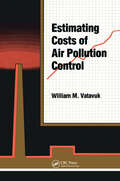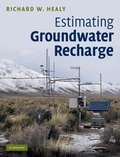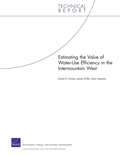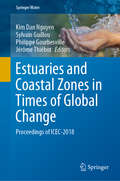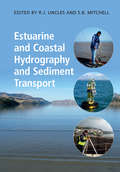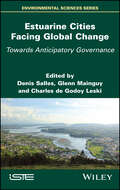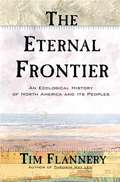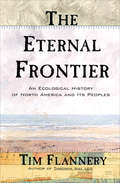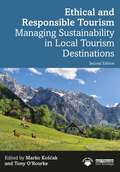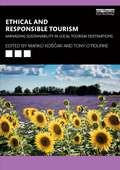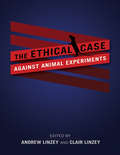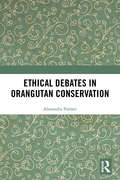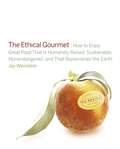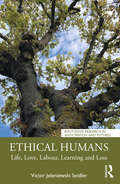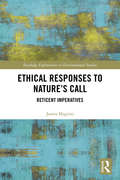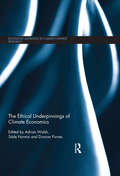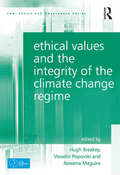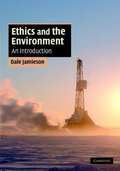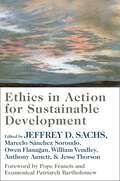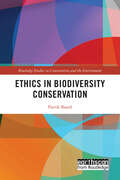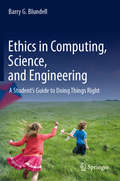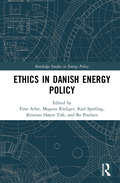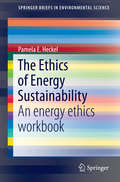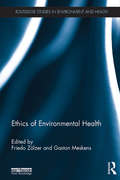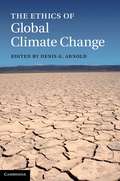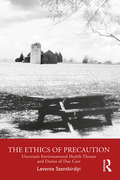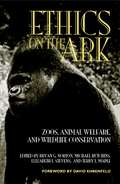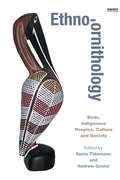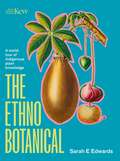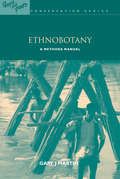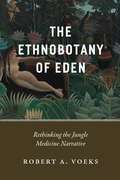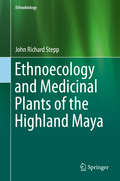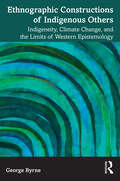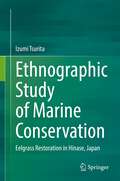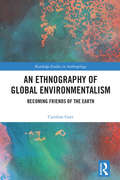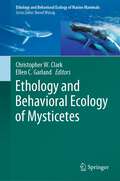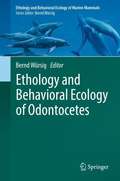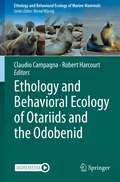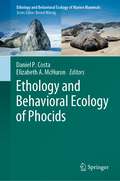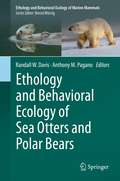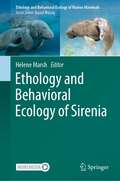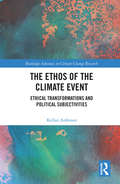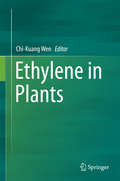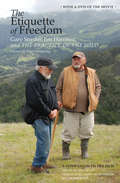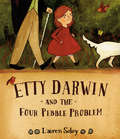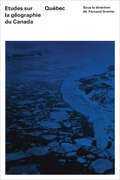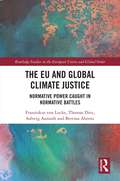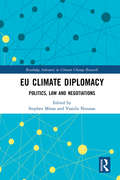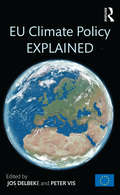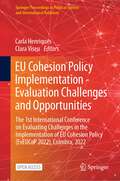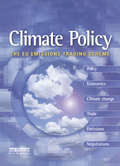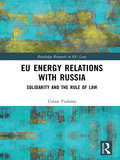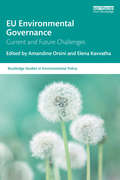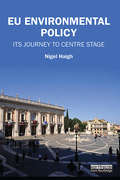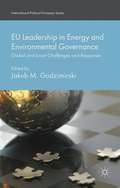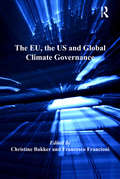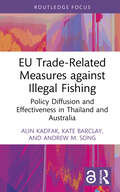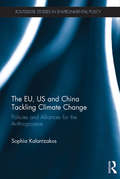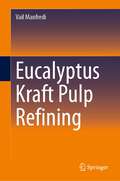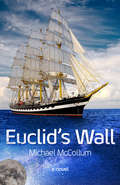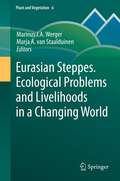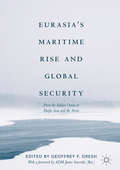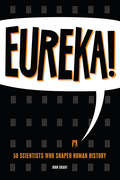Equivalency Methods for Environmental Liability
by Joshua Lipton Ece Özdemiroğlu David Chapman Jennifer PeersThe book is the only technical volume that explains how equivalency analysis methods mentioned in Annex II of the European Environmental Liability Directive should be implemented. It uses case studies to illustrate real-world application of the methods, which are based on the experience in the USA and in the European Union and have been tested in three years of training programs funded by the European Commission. Academically rigorous and technically comprehensive, the book is intended for technical experts wanting to assess damage and remediation options as well as for decision-makers wishing to commission such assessments and judge their quality. These include competent authorities, operators, financial security providers, academics, consultants and NGOs.
Eric Sloane's Weather Book
by Eric SloaneThe author instructs readers how to glean climate information by "reading" such natural phenomena as winds, skies, and animal sounds. A beautifully illustrated and practical treasure trove of enlightening lore for outdoorsmen, farmers, sailors, and anyone who has ever wondered whether to take an umbrella when leaving the house.
The Eros of Everyday Life: Essays on Ecology, Gender and Society
by Susan GriffinA brilliant collection of thought-provoking essays on gender, nature, passion, and society from an acclaimed feminist, philosopher, and poet In The Eros of Everyday Life, one of America's most provocative writers and thinkers offers insightful and compelling views on a wide range of social, ecological, and gender issues. From a distinctly feminist point of view, Susan Griffin explores the intricate connections between science and religion, nature and society, women and men, and love and consciousness. She brilliantly commingles lyrical memoir with cogent social commentary, producing a colorful literary tapestry that examines contemporary life and culture, its contradictions and complexities, and the rise of new ideologies. The Eros of Everyday Life showcases a decade's worth of the very best writing by this acclaimed Pulitzer Prize and National Book Critics Circle Award finalist. It is an enthralling anthology that reveals the ways in which Western society undermines itself by diminishing both woman and the natural environment, and yet it is also a celebration of the power of passion, and the remarkable evolution of the human capacity for love.
Erosion: Changing Earth's Surface
by Matthew Harrad Robin KoontzDid you know that rain, waves, wind, snow, and ice can change the shape of Earth's surface? They can create valleys, sea stacks, caves, and rock arches. Learn about the natural forces of erosion and how they shape the land.
Erosion (Earth Materials and Systems)
by Tamra B. OrrErosion changes Earth's natural features. It breaks down materials and can help make something new. Discover why erosion is an important part of nature!
Erosion: How Land Forms, How It Changes (Exploring Science: Earth Science Ser.)
by Darlene R. StilleErosion: How Land Forms, How It Changes
by Darlene R. StilleErosion is constantly changing, creating, and erasing features on Earth's surface. The issue of erosion is complex. By learning more about it, we understand when and how to prevent erosion and when to let this powerful force of nature do its work alone.
Errant Journeys: Adventure Travel in a Modern Age
by David ZurickIn this pathfinding book, David Zurick explores the fastest-growing segment of the travel industry--adventure travel. He raises important questions about what constitutes the travel experience and shows how the modern adventure industry has commercialized the very notion of adventure by packaging it as tours.
Escape from Fear
by Gloria Skurzynski Alane FergusonSomething in the Virgin Islands National Park is destroying the coral reefs and causing the hawksbill sea turtle to disappear--and the Landons are trying to figure out what. Jack and Ashley soon become involved with the son of a U. S. diplomat who is anxious to save an island woman. What secret do they share? Includes a park map.
Escape from Lucania: An Epic Story of Survival
by David RobertsIn 1937, Mount Lucania was the highest unclimbed peak in North America. Located deep within the Saint Elias mountain range, which straddles the border of Alaska and the Yukon, and surrounded by glacial peaks, Lucania was all but inaccessible. The leader of one failed expedition deemed it "impregnable." But in that year, a pair of daring young climbers would attempt a first ascent, not knowing that their quest would turn into a perilous struggle for survival. Escape from Lucania is their remarkable story.Classmates and fellow members of the Harvard Mountaineering Club, Brad Washburn and Bob Bates were two talented young men -- handsome, intelligent, and filled with a zest for exploring. Both were ambitious climbers, part of a small group whose first ascents in the great mountain ranges during the 1930s and 1940s changed the face of American mountaineering. Setting their sights on summitting Lucania in the summer of 1937, Washburn and Bates put together a team of four climbers for the expedition. But when Bates and Washburn flew to the Walsh Glacier at the foot of Lucania, they discovered that freakish weather conditions had turned the ice to slush. Their pilot was barely able to take off again alone, and there was no question of returning with the other two climbers or more supplies. Washburn and Bates found themselves marooned on the glacier, more than a hundred miles from help, in forbidding and desolate territory. Eschewing a trek out to the nearest mining town -- eighty miles away by air -- they decided to press ahead with their expedition. Escape from Lucania recounts Washburn and Bates's determined drive toward Lucania's 17,150-foot summit under constant threat of avalanches, blinding snowstorms, and hidden crevasses. Against awesome odds they became the first to set foot on Lucania's peak, not realizing that their greatest challenge still lay beyond. Nearly a month after being stranded on the glacier and with their supplies running dangerously low, they would have to navigate their way out through uncharted Yukon territory, racing against time as the summer warmth caused rivers to swell and flood to unfordable depths. But even as their situation grew more and more desperate, they refused to give up. Escape from Lucania tells this amazing story in thrilling and vivid detail, from the climbers' exultation at reaching the summit to their darkest moments confronting seemingly insurmountable obstacles. It is a tale of awesome adventure and harrowing danger. But above all it is the story of two men of extraordinary spirit, inspiring comradeship, and great courage. Today Washburn and Bates, now in their nineties, are legends in climbing circles. Bates co-led 1938 and 1953 expeditions to K2, the world's second-highest mountain. Washburn, whose record of Alaskan first ascents is unmatched, became founding director of Boston's Museum of Science and is one of the premier mountain photographers in the world. Some of his remarkable images from the 1937 Lucania expedition are included in this book.
The Escape Industry: How Iconic and Innovative Brands Built the Travel Business
by Mark TungateTravel as a concept is universally attractive and the opportunities for fun, engaging branding and marketing in this sector are arguably limitless. Glamour and appeal aside, travel is a hugely competitive, multi-million pound industry and marketers of all sectors can learn important lessons from it. Catering for mass consumer travel, from business travel and adventure travel, to specialist and niche interests, the providers of escape have been impacted as much by technology as they have by the changing habits and desires of travellers themselves. The Escape Industry presents an expert view of travel marketing and branding, focusing particularly on how travel has been utterly transformed for both consumers and providers since the beginning of the 21st century. Mark Tungate focuses on some of the travel industry's most famous brands and shares how all marketers can learn from the industry's rich experience of digital transition.Tungate traces the evolution of this fascinating industry, from nineteenth century trailblazers such as Thomas Cook and The Ritz, to today's innovations such as TripAdvisor, Couchsurfing and Airbnb, and explores the branding secrets that have enabled them to survive. A lively read full of incidents, anecdotes, unexpected encounters and a ground-breaking report from the final frontier and space tourism, The Escape Industry is at the cutting edge of this attractive sector, examining some of the biggest names in the industry. It will take travel and tourism students, as well as marketing and branding practitioners, on a journey to the heart of a rapidly changing business.
Escaping Nature: How to Survive Global Climate Change
by Orrin H. Pilkey Charles O. Pilkey Linda P. Pilkey-Jarvis Norma J. Longo Keith C. Pilkey Fred B. Dodson Hannah L. HayesIndustrial and agricultural greenhouse gas emissions are rapidly warming Earth’s climate, unleashing rising seas, ocean acidification, melting permafrost, powerful storms, wildfires, floods, deadly heat waves, droughts, tsunamis, food shortages, and armed conflict over shrinking water supplies while reducing nutritional levels in crops. Billions of people will become climate refugees. Hotter temperatures will allow tropical diseases to spread into temperate regions. Higher levels of CO2, allergens, dust, and other particulate matter will impair our physical and mental health and even reduce our cognitive abilities. Climate change disproportionately affects the world’s poor. It also harms Nature, and could ultimately trigger a sixth mass extinction. In Escaping Nature, Orrin H. Pilkey and his coauthors offer concrete suggestions for how to respond to the threats posed by global climate change. They argue that while we wait for the world’s governments to get serious about mitigating climate change we can adapt to a hotter world through technological innovations, behavioral changes, nature-based solutions, political changes, and education.
Escaping the Dark, Gray City: Fear and Hope in Progressive-Era Conservation
by Benjamin Heber JohnsonA compelling and long-overdue exploration of the Progressive-era conservation movement, and its lasting effects on American culture, politics, and contemporary environmentalism The turn of the twentieth century caught America at a crossroads, shaking the dust from a bygone era and hurtling toward the promises of modernity. Factories, railroads, banks, and oil fields—all reshaped the American landscape and people. In the gulf between growing wealth and the ills of an urbanizing nation, the spirit of Progressivism emerged. Promising a return to democracy and a check on concentrated wealth, Progressives confronted this changing relationship to the environment—not only in the countryside but also in dense industrial cities and leafy suburbs. Drawing on extensive work in urban history and Progressive politics, Benjamin Heber Johnson weaves together environmental history, material culture, and politics to reveal the successes and failures of the conservation movement and its lasting legacy. By following the efforts of a broad range of people and groups—women’s clubs, labor advocates, architects, and politicians—Johnson shows how conservation embodied the ideals of Progressivism, ultimately becoming one of its most important legacies.
Escaping the Resource Curse (Initiative for Policy Dialogue at Columbia: Challenges in Development and Globalization)
by Humphreys Macartan Jeffrey D. Sachs Joseph E. Stiglitz Eds.The wealth derived from natural resources can have a tremendous impact on the economics and politics of producing countries. In the last quarter century, we have seen the surprising and sobering consequences of this wealth, producing what is now known as the "resource curse." Countries with large endowments of natural resources, such as oil and gas, often do worse than their poorer neighbors. Their resource wealth frequently leads to lower growth rates, greater volatility, more corruption, and, in extreme cases, devastating civil wars. In this volume, leading economists, lawyers, and political scientists address the fundamental channels generated by this wealth and examine the major decisions a country must make when faced with an abundance of a natural resource. They identify such problems as asymmetric bargaining power, limited access to information, the failure to engage in long-term planning, weak institutional structures, and missing mechanisms of accountability. They also provide a series of solutions, including recommendations for contracting with oil companies and allocating revenue; guidelines for negotiators; models for optimal auctions; and strategies to strengthen state-society linkages and public accountability. The contributors show that solutions to the resource curse do exist; yet, institutional innovations are necessary to align the incentives of key domestic and international actors, and this requires fundamental political changes and much greater levels of transparency than currently exist. It is becoming increasingly clear that past policies have not provided the benefits they promised. Escaping the Resource Curse lays out a path for radically improving the management of the world's natural resources.
Esculturas de la naturaleza (¡Arriba la Lectura!, Level M #25)
by Margaret FettyQuizá no lo sabías, pero el viento, el agua y el hielo transforman el suelo. Estas fuerzas actúan por millones de años y crean esculturas en la naturaleza. Descubre cómo lo hicieron y qué formas asombrosas crearon. NIMAC-sourced textbook
The Eskimo and the Oil Man: The Battle at the Top of the World for America's Future
by Bob ReissThe Arctic century is upon us. A great jockeying for power and influence has erupted among nations in the high north. At stake are trillions of dollars in profit or loss, US security, geopolitical influence and the fate of a fragile environment as well as the region's traditional people. As the ice melts and oil companies venture north, the polar regions may become the next Panama Canal, the next Arabian Peninsula-places on earth that remain relatively unknown in one century and become pivotal in the next. Now Shell oil plans to sink exploratory wells in the pristine waters off the North Slope of Alaska-a site that the company believes contains three times as much oil as the Gulf of Mexico.THE ESKIMO AND THE OIL MAN tells this story through the eyes of two men, one an Iñupiat Eskimo leader on Alaska's North Slope, the other the head of Shell Oil's Alaska venture. Their saga is set against the background of an undersea land rush in the Arctic, with Russian bombers appearing off Alaska's coast, and rapid changes in ice that put millions of sea mammals at risk. The men's decisions will affect the daily lives of all Americans, in their cities and towns and also in their pocketbooks. The story begins as a fight and ends with a surprise.In the spirit of Thomas L. Friedman's Hot, Flat, and Crowded, bestselling author Bob Reiss traveled in America's High North over three years and spent time with scientists, diplomats, military planners, Eskimo whale hunters and officials at the highest levels of the government. He traveled to remote villages and sailed on a US icebreaker. THE ESKIMO AND THE OIL MAN reflects the issues dividing every American community wrestling with the balance between energy use and environmental protection, our love of cheap gas and the romance of pristine wilderness.
Essays in Economics: Theories, Theorizing, Facts And Policies
by Wassily W. LeontiefFirst Published in 2015. Routledge is an imprint of Taylor & Francis, an Informa company.
Essays on Sustainability and Management
by Runa Sarkar Annapurna ShawThis book offers a comprehensive overview of sustainability and management in India and through its insightful essays highlights the complex and multifaceted nature of sustainability as a concept. It also demonstrates the debates surrounding the concept of sustainability and its ramifications for ground-level practice in managing organisations and for public policy. The contributions from sustainability enthusiasts, practitioners from disparate fields and academics working at the Indian Institute of Management Calcutta, have been divided into five themes: (1) sustainability as a normative concept; (2) sustainability concept at the global level, (3) sustainability practices in Indian organisations and consumer behaviour; (4) sustainability, corporate governance and corporate social responsibility and (5) sustainability: a critique of organisational practice and government regulation. The themes reflect both new and continuing issues confronting management in the country today. Examples and in-depth studies make it relevant to the grounded reality in India. The expertise and experience of the contributors ensure that readers are left with a grasp of our current understanding of how sustainability is related to society and business, the direction this understanding will take in the future.
The Essential Agrarian Reader: The Future of Culture, Community, and the Land
by Barbara Kingsolver Norman WirzbaAgrarian philosophy, a compelling worldview with advocates around the globe, encourages us to develop practices and policies that promote the sustainable health of the land, community, and culture. <P><P>In this remarkable anthology are fifteen essays from Wendell Berry, Vandana Shiva, Wes Jackson, Gene Logsdon, Brian Donahue, Eric Freyfogle, David Orr, and others. The Essential Agrarian Reader calls us to celebrate the gifts of the earth, through honest work and respect for the land.
The Essential Agrarian Reader: The Future of Culture, Community, and the Land
by Norman Wirzba“Eminently quotable and passionately argued essays” on living in harmony with the earth and each other, by Wes Jackson, Wendell Berry, and more (Library Journal, starred review).Includes a Foreword by Barbara KingsolverA compelling worldview with advocates from around the globe, agrarianism challenges the shortcomings of our industrial and technological economy. Not simply focused on farming, the agrarian outlook encourages us to develop practices and policies that promote the health of land, community, and culture. Agrarianism reminds us that no matter how urban we become, our survival will always be inextricably linked to the precious resources of soil, water, and air.Combining fresh insights from the disciplines of education, law, history, urban and regional planning, economics, philosophy, religion, ecology, politics, and agriculture, these original essays develop a sophisticated critique of our culture’s current relationship to the land, while offering practical alternatives. Leading agrarians, including Wendell Berry, Vandana Shiva, Wes Jackson, Gene Logsdon, Brian Donahue, Eric Freyfogle, and David Orr, explain how our goals should be redirected toward genuinely sustainable communities. These writers call us to an honest accounting and correction of our often-destructive ways. They suggest how our society can take practical steps toward integrating soils, watersheds, forests, wildlife, urban areas, and human populations into one great system—a responsible flourishing of our world and culture.
Essential Concepts of Global Environmental Governance
by Jean-Frédéric MorinAligning global governance to the challenges of sustainability is one of the most urgent international issues to be addressed. This book is a timely and up-to-date compilation of the main pieces of the global environmental governance puzzle. Essential Concepts of Global Environmental Governance synthesizes writing from an internationally diverse range of well-known experts. Each entry defines a central concept in global environmental governance, presents its historical evolution and related debates, and includes key bibliographical references. This new edition takes stock of several recent developments in global environmental politics including the 2015 Paris Agreement on Climate Change, the UN Global Pact for the Environment attempt in 2017, and the 2018 Oceans Plastics Charter. More precisely, this book: offers cutting-edge analysis of the state of global environmental governance; presents an up-to-date debate on sustainable development at the global level; gives an in-depth exploration of current architecture of global environmental governance; examines the interaction between environmental politics and other policy fields such as trade, development, and security; provides a critical review of the recent global environmental governance literature. Innovative thinking and high-profile expertise come together to create a volume that is accessible to students, scholars, and practitioners alike.
Essential Concepts of Global Environmental Governance
by Jean-Frederic Morin Amandine OrsiniAligning global governance to the challenges of sustainability is one of the most urgent environmental issues to be addressed. This book is a timely and up-to-date compilation of the main pieces of the global environmental governance puzzle. The book is comprised of 101 entries, each defining a central concept in global environmental governance, presenting its historical evolution, introducing related debates and including key bibliographical references and further reading. The entries combine analytical rigour with empirical description. The book: offers cutting edge analysis of the state of global environmental governance, raises an up-to-date debate on global governance for sustainable development, gives an in-depth exploration of current international architecture of global environmental governance, examines the interaction between environmental politics and other fields of governance such as trade, development and security, elaborates a critical review of the recent literature in global environmental governance. This unique work synthesizes writing from an internationally diverse range of well-known experts in the field of global environmental governance. Innovative thinking and high-profile expertise come together to create a volume that is accessible to students, scholars and practitioners alike.
The Essential Guide to Rocky Mountain Mushrooms by Habitat
by Vera Evenson Michael Kuo Cathy CrippsFrom grassland fairy circles to alpine nano-shrooms, the Rocky Mountain region invites mushroom hunters to range though a mycological nirvana. Accessible and scientifically up-to-date, The Essential Guide to Rocky Mountain Mushrooms by Habitat is the definitive reference for uncovering post-rain rarities and kitchen favorites alike. Dazzling full-color photos highlight the beauty of hundreds of species. Easy-to-navigate entries offer essential descriptions and tips for identifying mushrooms, including each species' edibility, odor, taste, and rumored medicinal properties. The authors organize the mushrooms according to habitat zone. This ecology-centered approach places each species among surrounding flora and fauna and provides a trove of fascinating insights on how these charismatic fungi interact with the greater living world.
The Essential Guide to Wood Pallet Projects: 40 DIY Designs—Stunning Ideas for Furniture, Decor, and More
by Samantha Hartman Danny DarkeRustic meets modern with this charming do-it-yourself guide. Here are 40 easy-to-follow designs, ranging from coffee tables and wine racks to decorative wall art, all with step-by-step and clear full-color photographs. Perfect for those looking for simple and creative ways to decorate their homes. Wooden shipping pallets have found an unlikely second life: beautiful, handcrafted home décor without the designer price. The DIY market has long been drawn to refurbishing furniture and interior design on a budget, but easily accessible wood pallets have opened up all-new and inspiring ways to personalize a home in an eco-friendly, low-cost way. Beginner and veteran DIYers alike can take delight in crafting various furniture and décor that will impress and inspire without breaking the bank. Included within are instructions on how to make the following projects: Hanging ShelfDeck ChairWall-Hanging Mason Jar OrganizerPallet-Mounted Bottle OpenerWall-Mounted Coat RackSconcesDoor Handle Serving TrayPallet Arrow Wall ArtOutdoor Flower BoxFlower Arrangement CenterpieceClothes Pin Picture FrameRustic NightstandShabby Chic ToolboxFarmhouse Spice RackFarmhouse Wall ClockTealight Candle HoldersAnd more! With wooden pallets, the scope of the project is boundless, and warehouses and stores are happy to give them away for free. What was once a scavenger hunt and test of skill for experienced DIYers can now be an easy weekend project for even the newest of crafters. Take pride in creating imaginative home stylings with found and reclaimed materials that will help the environment, save you money, and make your home even more lovely!
Essential Invitation To Oceanography
by Paul PinetIntended for the more concise course, Essential Invitation to Oceanography provides a thorough introduction to oceanographic concepts while omitting advanced topics that some courses do not require. Written for the non-science student, this text lets readers explore how the oceans work while explaining their relevance within the four major divisions of ocean science--geology, chemistry, physics, and biology. A student-friendly writing style and rich pedagogy help students fully understand and retain the important concepts at hand, and feature boxes throughout engage them with the fascinating discoveries in oceanography.
Essential Muir (Revised): A Selection of John Muir’s Best (and Worst) Writings
by John MuirEssayist. Preservationist. Mountain man. Inventor. John Muir may be California’s best-known icon. A literary naturalist and founder of the Sierra Club and Yosemite National Park, Muir left his legacy on the landscape and on paper. But the celebrity of John Muir does not tell the whole story. In Essential Muir, for the first time, Muir's selected writings include those that show his ecological vision without ignoring his racism, providing a more complete portrait of the man. Taking the best of John Muir’s writings on nature and placing them alongside his musings on religion, society, and his fellow humans, Essential Muir asks the reader to consider how these connect, and what that means for Muir’s legacy in environmentalism today. Fred D. White’s selections from Muir’s writings, and his illuminating commentary in his revised introduction, reveal the complex man and writer behind the iconic name. In the new foreword, Jolie Varela (Tule River Yokut and Paiute) of Indigenous Women Hike speaks back to Muir, addressing the impact of his words and actions on California Indians. This collection, which highlights John Muir’s charms and confronts his flaws, is vital for understanding the history of environmental thought.
Essential Oil Research: Trends in Biosynthesis, Analytics, Industrial Applications and Biotechnological Production
by Sonia MalikThis book highlights the advances in essential oil research, from the plant physiology perspective to large-scale production, including bioanalytical methods and industrial applications. The book is divided into 4 sections. The first one is focused on essential oil composition and why plants produce these compounds that have been used by humans since ancient times. Part 2 presents an update on the use of essential oils in various areas, including food and pharma industries as well as agriculture. In part 3 readers will find new trends in bioanalytical methods. Lastly, part 4 presents a number of approaches to increase essential oil production, such as in vitro and hairy root culture, metabolic engineering and biotechnology. Altogether, this volume offers a comprehensive look at what researchers have been doing over the last years to better understand these compounds and how to explore them for the benefit of the society.
The Essential Outdoor Gear Manual: Equipment Care and Repair for Outdoorspeople
by Annie GetchellThis book covers repairs on the trail or at home. Techniques range from patching a rain jacket to patching a canoe, fixing broken zipper slides to reweaving snowshoe webbing, cleaning campstove jets to filing ice axe teeth. Getchell augments her concise hands-on instructions with numerous anecdotes from outdoor experts, creating a rich, captivating blend of field-based, real-world knowledge guidance. This comprehensive, multisport reference covers climbing hardware, tents, sleeping bags, hiking boots, binoculars, to name a few. The emphasis is as much on care as repair, since more of the former means less of the latter. Appendices offer trail-tested repair kits for specific activities, knots stitches, adhesives, nontoxic cleaning solutions.
Essential Perennials: The Complete Reference to 2700 Perennials for the Home Garden
by Alan L. Detrick Thomas Christopher Ruth Rogers ClausenEssential Perennials focuses on what every gardener needs to know to choose from the thousands of perennials available, and care for the ones you already have. This A-to-Z guide is packed with more than 2,700 plants, with each entry listing flower color, bloom time, foliage characteristics, size, and light and temperature requirements. Each profile is supported by stunning color photography that showcases the flower and foliage that make each plant unique.
The Essential T.S. Eliot
by T.S. EliotA selection of the most significant and enduring poems from one of the twentieth century’s major writers, chosen and introduced by Vijay SeshadriT.S. Eliot was a towering figure in twentieth century literature, a renowned poet, playwright, and critic whose work—including “The Love Song of J. Alfred Prufrock” (1915), The Waste Land (1922), Four Quartets (1943), and Murder in the Cathedral (1935)—continues to be among the most-read and influential in the canon of American literature. The Essential T.S. Eliot collects Eliot’s most lasting and important poetry in one career-spanning volume, now with an introduction from Vijay Seshadri, one of our foremost poets.
Essential Techniques of Landscape Drawing: Master the Concepts and Methods for Observing and Rendering Nature
by Suzanne BrookerThis beginner's guide to drawing in graphite pencil uses step-by-step exercises to teach fundamental methods for rendering all aspects of the natural landscape, with additional lessons on using charcoal, colored pencil, pastel, and other media.Following in the footsteps of author, artist, and art instructor Suzanne Brooker's previous title The Elements of Landscape Oil Painting, this book pairs the most universally-pursued topic for artists (drawing) with the popular subject matter of the natural landscape. Brooker breaks down landscapes into their various elements--including the earth, water, air, and trees--to convey how the fundamentals of drawing are applied to capture each aspect. Using the graphite pencil as her baseline instrument, Brooker provides you with step-by-step lessons that help you improve your rendering skills and re-create the beauty of the world outdoors. Examples from art history and contemporary masters supplement these lessons. The end result is a drawing instruction book that provides artists with everything they need to render landscapes no matter their skill level.
Essentials of Environmental Science
by Andrew Friedland Rick RelyeaWith streamlined coverage of ecology, agriculture, energy, and water Essentials of Environmental Science provides a focused treatment of science concepts to help students think critically about the data presented.
Essentials of Oceanography
by Alan P. Trujillo Harold V. ThurmanAs the bestselling brief book in the oceanography market, Essentials of Oceanography combines dynamic visuals and a student-friendly narrative to bring oceanography to life. The text’s engaging features and the extensive suite of animations and videos keep students interested and excited about the material. <p><p> The 13th Edition creates an interactive learning experience that provides tightly integrated text and digital offerings to make oceanography approachable and digestible for students. An emphasis on the process of science throughout the text provides students with an understanding of how scientists think and work. The new edition also helps students develop the scientific skill of practicing and interpreting data with new Exploring Data features supported by Mastering Oceanography coaching activities. A new Creature Feature provides fun facts about marine animals to engage students.
Essentials of World Regional Geography (4th edition)
by Christopher L. Salter Joseph J. HobbsKit Salter and Joe Hobbs build the story of each region using contemporary concerns, global issues, and historical themes to create a complete picture of our ever-changing planet and its people.
Estamos agradecidos: Otsaliheliga
by Traci Sorell¡Ahora en español! La comunidad cheroqui está agradecida por los logros y desafíos que experimentan en cada estación. En este libro se cuenta la vida moderna de los nativos americanos, narrada por una ciudadana de la Nación Cheroqui.Now in Spanish! The Cherokee community is grateful for blessings and challenges that each season brings. This is modern Native American life as told by an enrolled citizen of the Cherokee Nation.Los ciudadanos de la Nación Cheroqui emplean la palabra otsaliheliga (o-ya-LI-ge-li-ga) para expresar gratitud. A partir del año nuevo cheroqui, que ocurre en otoño, hasta el verano, el año cheroqui está lleno de celebraciones y experiencias. Este libro, escrito por una ciudadana de la Nación Cheroqui, describe a un grupo de nativos americanos y finaliza con un glosario y un silabario cheroqui completo, creado por Sequoyah.The word otsaliheliga (oh-jah-LEE-hay-lee-gah) is used by members of the Cherokee Nation to express gratitude. Beginning in the fall with the new year and ending in summer, follow a full Cherokee year of celebrations and experiences. The complete Cherokee syllabary, originally created by Sequoyah, is included.
Estimating Climate Sensitivity: Report Of A Workshop
by Board on Atmospheric Sciences Climate“Climate sensitivity” is a term used to characterize the response of the climate system to an imposed forcing, and is most commonly used to mean the equilibrium global mean surface temperature change that occurs in response to a doubling of atmospheric carbon dioxide concentration. The purpose of this workshop was to explore current capabilities and limitations in quantifying climate sensitivity and consider whether there are alternative approaches for characterizing climate response that might better suit the information needs of policy makers.
Estimating Costs of Air Pollution Control
by William M. VatavukIn these pages is all the information that you-manager, engineer, or other technical professional-would need to select, size, and estimate "budget/study" level capital and annual costs for a variety of air pollution control equipment. This equipment includes wet scrubbers, carbon adsorbers, and other "add-on" devices. This book also deals with such nonstack controls as wet dust suppression systems and flue gas desulfurization systems. The costs are current (1988 or 1989 dollars) and are mainly presented in equational form for ease of computerization and updating. Clear, comprehensive equipment sizing procedures are also detailed. Finally, several detailed example problems are included to illustrate the sizing and costing procedures. This book is not just for technical personnel, however. The material is easy to grasp and use. Anyone with an air pollution control background can follow and apply the procedures and data herein. Using this book, air pollution control professionals can now develop sound, defensible (within ±30%) cost estimates with a minimum of time and effort.
Estimating Groundwater Recharge
by Richard W. Healy Bridget R. ScanlonUnderstanding groundwater recharge is essential for successful management of water resources and modeling fluid and contaminant transport within the subsurface. This book provides a critical evaluation of the theory and assumptions that underlie methods for estimating rates of groundwater recharge. Detailed explanations of the methods are provided - allowing readers to apply many of the techniques themselves without needing to consult additional references. Numerous practical examples highlight benefits and limitations of each method. Approximately 900 references allow advanced practitioners to pursue additional information on any method. For the first time, theoretical and practical considerations for selecting and applying methods for estimating groundwater recharge are covered in a single volume with uniform presentation. Hydrogeologists, water-resource specialists, civil and agricultural engineers, earth and environmental scientists and agronomists will benefit from this informative and practical book, which is also a useful adjunct text for advanced courses in groundwater or hydrogeology.
Estimating the Value of Water-Use Efficiency in the Intermountain West
by James Griffin David G. Groves Sara HajiamiriThis report presents an economic framework for estimating a water agency's avoided costs and environmental benefits of increasing water-use efficiency. The report demonstrates this framework by evaluating the benefits of Denver Water's efficiency programs and utilizes an exploratory modeling approach to accommodate significant uncertainty. The analysis highlights the importance of considering both long- and short-run costs and benefits.
Estuaries and Coastal Zones in Times of Global Change: Proceedings of ICEC-2018 (Springer Water)
by Philippe Gourbesville Kim Dan Nguyen Sylvain Guillou Jérôme ThiébotThis book is a collection of extended papers based on presentations given during the ICEC 2018 conference, held in Caen, France, in August 2018. It explores both the limitations and advantages of current models, and highlights the latest developments concerning new numerical schemes, high-performance computing, multi-physics and multi-scale methods, and better interaction with field or scale model data. Accordingly, it addresses the interests of practitioners, stakeholders, researchers, and engineers active in this field.
Estuarine and Coastal Hydrography and Sediment Transport
by Mitchell R. J. Uncles S. B.A practical guide to the latest remote and in situ techniques used to measure sediments, quantify seabed characteristics, and understand physical properties of water and sediments and transport mechanisms in estuaries and coastal waters. Covering a broad range of topics from global reference frames and bathymetric surveying methods to the use of remote sensing for determining surface-water variables, enough background is included to explain how each technology functions. The advantages and disadvantages of each technology are explained, and a review of recent fieldwork experiments demonstrates how modern methods apply in real-life estuarine and coastal campaigns. Clear explanations of physical processes show links between different disciplines, making the book ideal for students and researchers in the environmental sciences, marine biology, chemistry and geology, whose work relies on an understanding of the physical environment and the way it is changing as a result of climate change, engineering and other influences.
Estuarine Cities Facing Global Change: Towards Anticipatory Governance
by Denis Salles Glenn Mainguy Charles de Godoy LeskiAt the heart of the globalization of trade and of economies, estuarine cities are at the forefront of accelerating global change. They must confront the tensions generated by their demographic and socio-economic attractions and their ecological vulnerability linked to their location in trade flows, downstream of rivers and at the interface between land and sea. Using the examples of the estuarine cities of the Gironde, the Loire and the Seine and their specific challenges, such as climate change, flood risk, biodiversity, port flows and urban planning, this book analyzes their emerging trajectories guided by proactive governance of global change.
The Eternal Frontier: An Ecological History of North America and Its Peoples
by Tim FlanneryIn "The Eternal Frontier," scientist and historian Flannery tells the story of the geological and biological evolution of the North American continent, from the time of the asteroid strike that ended the age of dinosaurs 65 million years ago, to the present day.
The Eternal Frontier: An Ecological History of North America and Its Peoples
by Tim FlannerySixty-five million years ago, a meteor six miles wide smashed into the Gulf of Mexico, ending the age of dinosaurs and devastating the North American continent. Starting with this catastrophic event, The Eternal Frontier recounts the extraordinary ecological history of North America, showing how the continent originally came into being and eventually transformed into the landscape we know today. This sweeping, multidisciplinary book is history on an epic scale. Tim Flannery, a world-renowned paleontologist, traces the postmeteor rebirth of plants, animals, climate, and landforms. He describes a time when rain forests flourished in Greenland and when giant long-necked camels and fat aquatic rhinos thrived in North America’s golden age. He explores the massive changes wrought by the ice ages and shows how geological and climatic forces shaped both the autumn foliage in New England and the cacti in the Sonoran Desert. As the story moves across vast distances of time and geography, we eventually witness the impact of the human race. Flannery imagines the first humans to have immigrated 14,000 years ago, after the recession of the last ice age, and he explains how the pioneering Clovis hunters exterminated an ice-age fauna, including enormous mammoths and mastodons and half-ton lions. The story continues right up to the present, covering the deforestation of the Northeast, the decimation of the buffalo, and other facets of the impact of frontier settlement and the development of modern industry and commerce. The Eternal Frontier is science writing at its best, combining an enormous wealth of fascinating information with engaging prose that will be accessible to readers of any background.
Ethical Adaptation to Climate Change
by Allen Thompson Jeremy Bendik-KeymerPredictions about global climate change have produced both stark scenarios of environmental catastrophe and purportedly pragmatic ideas about adaptation. This book takes a different perspective, exploring the idea that the challenge of adapting to global climate change is fundamentally an ethical one, that it is not simply a matter of adapting our infrastructures and economies to mitigate damage but rather of adapting ourselves to realities of a new global climate. The challenge is to restore our conception of humanity--to understand human flourishing in new ways--in an age in which humanity shapes the basic conditions of the global environment. In the face of what we have unintentionally done to Earth's ecology, who shall we become? The contributors examine ways that new realities will require us to revisit and adjust the practice of ecological restoration; the place of ecology in our conception of justice; the form and substance of traditional virtues and vices; and the organizations, scale, and underlying metaphors of important institutions. Topics discussed include historical fidelity in ecological restoration; the application of capability theory to ecology; the questionable ethics of geoengineering; and the cognitive transformation required if we are to "think like a planet. "
Ethical and Responsible Tourism: Managing Sustainability in Local Tourism Destinations
by Marko KoščakEthical and Responsible Tourism explains the methods and practices used to manage the environmental impact of tourism on local communities and destinations. This new edition takes into account recent global events such as the Covid-19 health crisis, the impacts of the war in Ukraine on tourism in neighbouring regions and the consequences of the energy and cost of living crisis. The three core themes of the book – destination management, environmental and social aspects of ethical sustainable development and business impacts – are discussed across both topic and case study chapters, alongside explanatory editorial analysis with all chapters clearly signposted and interlinked. The case studies address specific and practical examples from a global range of examples including sites in Australasia, Central America, Europe, Asia, North America and South America. In this new edition, further case studies are included from the USA and Japan, as well as new examples from Brazil, Croatia and Malta. Used as a core textbook, the linking of theory in the topic chapters, and practice gained through case studies, alongside further reading and editorial commentary, Ethical and Responsible Tourism provides a detailed and comprehensive learning experience. Specific case studies can be used as standalone examples as part of a case teaching approach, and the editorial and discussion elements are designed to be suitable for those simply seeking a concise overview, such as tourism professionals or potential investors in sustainable tourism projects. This revised edition continues to be essential reading for students, researchers and practitioners of tourism, environmental and sustainability studies.
Ethical and Responsible Tourism: Managing Sustainability in Local Tourism Destinations
by Tony O'Rourke Marko Kos AkEthical and Responsible Tourism explains the methods and practices used to manage the environmental impact of tourism on local communities and destinations. The three core themes of the book – destination management, environmental and social aspects of ethical sustainable development and business impacts – are discussed across both topic and case study chapters, alongside explanatory editorial analysis with all chapters clearly signposted and interlinked. The case studies address specific and practical examples from a global range of examples including sites in Australia, Central America, Europe Union countries, Japan, North America and South America. Used as a core textbook, the linking of theory in the topic chapters, and practice gained through case studies, alongside further reading and editorial commentary, Ethical and Responsible Tourism provides a detailed and comprehensive learning experience. Specific case studies can be used as standalone examples as part of a case teaching approach, and the editorial and discussion elements are designed to be suitable for those simply seeking a concise overview, such as tourism professionals or potential investors in sustainable tourism projects. This book will be essential reading for students, researchers and practitioners of tourism, environmental and sustainability studies.
The Ethical Case against Animal Experiments
by Andrew Linzey Clair LinzeyAt present, human beings worldwide are using an estimated 115.3 million animals in experiments ”a normalization of the unthinkable on an immense scale. In terms of harm, pain, suffering, and death, animal experiments constitute one of the major moral issues of our time. Given today's deeper understanding of animal sentience, we must afford animals a special moral consideration that precludes their use in experiments. The Ethical Case against Animal Experiments begins with a groundbreaking and comprehensive ethical critique of the practice of animal experiments by the Oxford Centre for Animal Ethics. A second section offers original writings that engage with, and elaborate on, aspects of the Oxford Centre report. The essayists explore historical, philosophical, and personal perspectives that range from animal experiments in classical times to the place of necessity in animal research to one researcher's painful journey from researcher to opponent. A devastating look at a contemporary moral crisis, The Ethical Case against Animal Experiments melds logic to compassion to mount a powerful challenge to human cruelty.
Ethical Debates in Orangutan Conservation
by Alexandra PalmerEthical Debates in Orangutan Conservation explores how conservationists decide whether, and how, to undertake rehabilitation and reintroduction (R&R) when rescuing orphaned orangutans. The author demonstrates that exploring ethical dilemmas is crucial for understanding ongoing disagreements about how to help endangered wildlife in an era of anthropogenic extinction. Although R&R might appear an uncontroversial activity, there is considerable debate about how, and why, it ought to be practised. Drawing on in-depth qualitative research with orangutan conservation practitioners, this book examines how ethical trade-offs shape debates about R&R. For example, what if the orphan fails to learn how to be an orangutan again, after years in the company of humans? What if she is sent into the forest only to slowly starve? Would she have been better off in a cage? Could the huge cost of sending a rescued ape back to the wild be better spent on stopping deforestation in the first place? Or do we have a moral obligation to rescue the orphan regardless of cost? This book demonstrates that deconstructing ethical positions is crucial for understanding ongoing disagreements about how to help our endangered great ape kin and other wildlife. Ethical Debates in Orangutan Conservation is essential reading for those interested in conservation and animal welfare, animal studies, primatology, geography, environmental philosophy, and anthropology.
The Ethical Gourmet: How to Enjoy Great Food That Is Humanely Raised, Sustainable, Nonendangered and That Replenishes the Earth
by Jay WeinsteinMore and more of us want to ensure that what we eat doesn't deplete resources, cause animal or human suffering, or lead to pollution. And, at the same time, we also want delicious food! If you are concerned about the environment, but unsure how to make a difference, here is a handbook for finding and cooking environmentally friendly and ethically produced foods. Chef and environmentalist Jay Weinstein has written the bible for those who care about both the well-being of the world and flavorful food. He informs us: * When organics really matter * Where to source humanely-raised meats and other ethically produced foods * How to make choices with a clean conscience when dining out. He also explores subjects ranging from genetically modified foods to being savvy about farmed fish, and why to avoid disposable wooden chopsticks and bottled water. By providing 100 healthy, sophisticated, and mouthwatering recipes, Jay Weinstein ensures that our ethical impulses are well rewarded. Dishes like Manchego-Potato Tacos with Pickled Jalapeños, Zucchini Spaghetti with Garlicky Clams and Grilled Bluefish, Pumpkin Basmati Rice Pilaf, and Coco-Vegetable Rice with Tamarind Chicken Skewers feature creative ways to use eco-friendly vegetables and legumes, sustainable seafood, and humanely raised animals.
Ethical Humans: Life, Love, Labour, Learning and Loss (Routledge Research in Anticipation and Futures)
by Victor Jeleniewski SeidlerEthical Humans questions how philosophy and social theory can help us to engage the everyday moral realities of living, working, loving, learning and dying in new capitalism. It introduces sociology as an art of living and as a formative tradition of embodied radical eco post-humanism. Seeking to embody traditions of philosophy and social theory in everyday ethics, this book validates emotions and feelings as sources of knowledge and shows how the denigration of women has gone hand in hand with the denigration of nature. It queries post-structuralist traditions of anti-humanism that, for all their insights into the fragmentation of identities, often sustain a distinction between nature and culture. The author argues that in a crisis of global warming, we have to learn to listen to our bodies as part of nature and draws on Wittgenstein to shape embodied forms of philosophy and social theory that questions theologies that tacitly continue to shape philosophical traditions. In acknowledging our own vulnerabilities, we question the vision of the autonomous and independent rational self that often remains within the terms of dominant white masculinities. This book offers different modes of self-work, drawing on psychoanalysis and embodied post-analytic psychotherapies as part of a decolonising practice questioning Eurocentric colonising modernity. In doing so it challenges, with Simone Weil, Roman notions of power and greatness that have shaped visions of white supremacy and European colonial power and empire. This book will be of great interest to students and scholars of environmental ethics, environmental philosophy, social theory and sociology, ethics and philosophy, cultural studies, future studies, gender studies, post-colonial studies, Marxism, psychoanalysis and psychotherapy and philosophy and sociology as arts of living.
Ethical Responses to Nature’s Call: Reticent Imperatives (Routledge Explorations in Environmental Studies)
by James MagriniArguing for a renewed view of objects and nature, Ethical Responses to Nature’s Call considers how it is possible to understand our ethical duties - in the form of ethical intuitionalism - to nature and the planet by listening to and releasing ourselves over to the call or address of nature. Blending several strands of philosophical thought, such as Graham Harman’s Object-Oriented Ontology, W. D. Ross’s prima fathics, Alphonso Lingis’s phenomenological ethics traceable to The Imperative, and Michael Bonnett’s ecophilosophy, this book offers a unique rejoinder to the problems and issues that continue to haunt humans’ relationship to nature. The origins of such problems and issues largely remain obscured from view due to the oppressive influence of the "Cultural Framework" which gives form and structure to the ways we understand, discourse on, and comport ourselves in relation to the natural world. Through understanding this "Cultural Framework" we also come to know the responses we continue to offer in answer to nature’s call and address, and are then in a position to analyze and assess those responses in terms of their potential ethical weight. Such a phenomenon is made possible through the descriptive-and-interpretive method of eco-phenomenology. This renewed vision of the human-and-nature provides direction for our interaction with and behavior toward nature in such a way that the ethical insight offers a diagnosis and provides a potentially compelling prescriptive for environmental ills.
The Ethical Underpinnings of Climate Economics (Routledge Advances in Climate Change Research)
by Adrian Walsh Säde Hormio Duncan PurvesDespite their obvious importance, the ethical implications of climate change are often neglected in economic evaluations of mitigation and adaptation policies. Economic climate models provide estimates of the value of mitigation benefits, provide understanding of the costs of reducing emissions, and develop tools for making policy choices under uncertainty. They have thus offered theoretical and empirical instruments for the design and implementation of a range of climate policies, but the ethical assumptions included in the calculations are usually left unarticulated. This book, which brings together scholars from both economics and ethical theory, explores the interrelation between climate ethics and economics. Examining a wide range of topics including sustainability, conceptions of value, risk management and the monetization of harm, the book will explore the ethical limitations of economic analysis but will not assume that economic theory cannot accommodate the concerns raised. The aim in part is to identify ethical shortcomings of economic analysis and to propose solutions. Given the on-going role of economics in government thinking on mitigation, a constructive approach is vital if we are to deal adequately with climate change. This volume will be of great interest to students and scholars of environmental ethics, economics, political science, political philosophy and the philosophy of economics.
Ethical Values and the Integrity of the Climate Change Regime (Law, Ethics and Governance)
by Hugh Breakey Vesselin PopovskiThis book investigates the ethical values that inform the global carbon integrity system, and reflects on alternative norms that could or should do so. The global carbon integrity system comprises the emerging international architecture being built to respond to the climate change. This architecture can be understood as an 'integrity system'- an inter-related set of institutions, governance arrangements, regulations and practices that work to ensure the system performs its role faithfully and effectively. This volume investigates the ways ethical values impact on where and how the integrity system works, where it fails, and how it can be improved. With a wide array of perspectives across many disciplines, including ethicists, philosophers, lawyers, governance experts and political theorists, the chapters seek to explore the positive values driving the global climate change processes, to offer an understanding of the motivations justifying the creation of the regime and the way that social norms impact upon the operation of the integrity system. The collection focuses on the nexus between ideal ethics and real-world implementation through institutions and laws. The book will be of interest to policy makers, climate change experts, carbon taxation regulators, academics, legal practitioners and researchers.
Ethics and the Environment: An Introduction
by Dale JamiesonThis book is an introduction to the philosophical issues involved in this important question, focussing primarily on ethics but also encompassing questions in aesthetics and political philosophy. Topics discussed include the environment as an ethical question, human morality, meta-ethics, normative ethics, humans and other animals, the value of nature, and nature's future.
Ethics in Action for Sustainable Development
by Sachs, Jeffrey D.; Sorondo, Marcelo Sánchez; Flanagan, Owen; Vendley, William; Annett, Anthony; Thorson, JesseThe Sustainable Development Goals, adopted by the United Nations in 2015, comprise an ambitious and sweeping agenda that unites economic, social, and environmental aims. What resources do the world’s religious and secular traditions offer in support of these objectives? Which principles do these traditions hold in common, and how can these shared values help advance global goals?This book presents an in-depth and deeply engaged conversation among interfaith religious leaders and interdisciplinary scholars and practitioners in pursuit of an ethical consensus that could ground sustainable development efforts. Drawing on more than two years of close-knit discussions convened by Jeffrey D. Sachs and Marcelo Sánchez Sorondo, it offers an extensive and inclusive vision of how to promote human flourishing. The book features theological, philosophical, and ethical deliberations of great diversity and depth on the challenges of sustainable development, addressing questions of poverty, environmental justice, peace, conflict, and the future of work. It includes consensus statements on the moral imperatives of sustainable development, introductions to seven major religious traditions and their conceptions of the common good, and thematic reflections. Wide-ranging and urgent, this book represents a major contribution to interreligious dialogue and to the articulation of a shared global ethics.The book features a foreword by Pope Francis and Ecumenical Patriarch Bartholomew.
Ethics in Biodiversity Conservation (Routledge Studies in Conservation and the Environment)
by Patrik BaardThis book examines the role of ethics and philosophy in biodiversity conservation. The objective of this book is two-fold: on the one hand it offers a detailed and systematic account of central normative concepts often used, but rarely explicated nor justified, within conservation biology. Such concepts include ‘values’ (both intrinsic, instrumental, and, more recently, relational), ‘rights’, and ‘duties’. The second objective is to emphasize to environmental philosophers and applied ethicists the many interesting decision-making challenges of biodiversity conservation. The book argues that a nuanced account of instrumental values provides a powerful tool for reasoning about the values of biodiversity. It also scrutinizes relational values, the concept of rights of nature, and risk, and show how moral philosophy proves indispensable for these concepts. Consequently, it engages with recent suggestions on normative aspects of biodiversity conservation, and show the need for moral philosophy in biodiversity conservation. The overriding aim of this book is to provide conservation biologists and policy-makers with a systematic overview of concepts and assessments of the reasons for reaching prescriptive conclusions about biodiversity conservation. This will prove instrumental in clarifying the role of applied ethics and a refined understanding of the tools it can provide. This title will be of interest to students and scholars of conservation biology, conservation policy, environmental ethics and environmental philosophy.
Ethics in Computing, Science, and Engineering: A Student’s Guide to Doing Things Right
by Barry G. BlundellThis comprehensive textbook introduces students to the wide-ranging responsibilities of computing, science and engineering professionals by laying strong transdisciplinary foundations and by highlighting ethical issues that may arise during their careers. The work is well illustrated, and makes extensive use of both activities, and ethical dilemmas which are designed to stimulate reader engagement. A number of memorable case studies are also included and frequently draw on the demanding aerospace industry. The book adopts a strongly human centric approach, with matters such as privacy erosion and censorship being viewed not only in their current context but also in terms of their ongoing evolution. What are our individual ethical responsibilities for ensuring that we do not develop for future generations a technological leviathan with the potential to create a dystopian world? A broad range of technologies and techniques are introduced and are examined within an ethical framework. These include biometrics, surveillance systems (including facial recognition), radio frequency identification devices, drone technologies, the Internet of Things, and robotic systems. The application and potential societal ramifications of such systems are examined in some detail and this is intended to support the reader in gaining a clear insight into our current direction of travel. Importantly, the author asks whether we can afford to allow ongoing developments to be primarily driven by market forces, or whether a more cautious approach is needed. Further chapters examine the benefits that are associated with ethical leadership, environmental issues relating to the technology product lifecycle (from inception to e-waste), ethical considerations in research (including medical experimentation involving both humans and animals), and the need to develop educational programs which will better prepare students for the needs of a much more fluid employment landscape. The final chapter introduces a structured approach to ethical issue resolution, providing a valuable, long-term source of reference. In addition it emphasises the ethical responsibilities of the professional, and considers issues that can arise when we endeavour to effect ethically sound change within organisations. Examples are provided which highlight the possible ramifications of exercising ethical valour. The author has thus created an extensively referenced textbook that catalyses student interest, is internationally relevant, and which is multicultural in both its scope and outlook.
Ethics in Danish Energy Policy (Routledge Studies in Energy Policy)
by Finn Arler Mogens Rüdiger Karl Sperling Kristian Høyer Toft Bo PoulsenThis book deepens our understanding of ethical drivers in energy policy and contributes to future decision-making on transitions towards a sustainable energy system. During the latest fifty years Western energy politics have been faced with a series of ethical challenges including rapid growth, oil crises, security of supply, nuclear power and climate change. Combining philosophical, historical and planning approaches into one narrative, these dilemmas are explored using Denmark as the key case study. Drawing on contributions from several experts in the field, the ethics of energy is investigated from multiple perspectives at the individual, corporate, local and national levels, focusing on concrete decisions where different ethical considerations are weighted against each other. This comprehensive approach helps to gain a deeper understanding of the energy sector’s history and gives important input to its future layout. Drawing comparisons with European and global examples, this book will be of great interest to students and scholars of energy politics and policy, environmental ethics, climate change and sustainability transitions.
The Ethics of Energy Sustainability
by Pamela E. HeckelThis book is an easy to use instructional aide. Explore sustainability issues in contemporary society through a transdisciplinary approach. Chapters include ethics, public resources, public policy, combustion, heat exchangers, nuclear, solar, water, and wind energy. A short summary is presented for each topic, followed by additional topics for research, assignments, and references. The complex assignments require students to grow in their professional judgment.
Ethics of Environmental Health (Routledge Studies in Environment and Health)
by Friedo Zölzer Gaston MeskensEnvironmental health encompasses the assessment and control of those environmental factors that can potentially affect human health, such as radiation, toxic chemicals and other hazardous agents. It is often assumed that the assessment part is just a matter of scientific research, and the control part a matter of implementing standards which unambiguously follow from that research. But it is less commonly understood that environmental health also requires addressing questions of an ethical nature. How can we determine the "acceptable" risk level for the general population or for certain groups? How should we deal with uneven distributions of risks and benefits? How do we communicate about risks with the stakeholders? This multidisciplinary collection brings together a number of leading researchers and scholars in order to generate discussion surrounding these key questions, and to bring the ethical implications of science and technology to the forefront of critical thought. Providing a broad overview of the Ethics of Environmental Health, its philosophical foundations and practical applications, this book offers a significant contribution to ongoing discussions in sustainable development and will be of interest to scholars and practitioners of Environmental Health, urban studies and healthcare.
The Ethics of Global Climate Change
by Denis G. ArnoldGlobal climate change is one of the most daunting ethical and political challenges confronting humanity in the twenty-first century. The intergenerational and transnational ethical issues raised by climate change have been the focus of a significant body of scholarship. In this new collection of essays, leading scholars engage and respond to first-generation scholarship and argue for new ways of thinking about our ethical obligations to present and future generations. Topics addressed in these essays include moral accountability for energy consumption and emissions, egalitarian and libertarian perspectives on mitigation, justice in relation to cap and trade schemes, the ethics of adaptation and the ethical dimensions of the impact of climate change on nature.
The Ethics of Precaution: Uncertain Environmental Health Threats and Duties of Due Care
by Levente SzentkirályiThere are thousands of substances manufactured in the United States to which the public is routinely exposed and for which toxicity data are limited or absent. Some insist that uncertainty about the severity of potential harm justifies implementing precautionary regulations, while others claim that uncertainty justifies the absence of regulations until sufficient evidence confirms a strong probability of severe harm. In this book, Levente Szentkirályi overcomes this impasse in his defense of precautionary environmental risk regulation by shifting the focus from how to manage uncertainty to what it is we owe each other morally. He argues that actions that create uncertain threats wrongfully gamble with the welfare of those who are exposed and neglect the reciprocity that our equal moral standing demands. If we take the moral equality and rights of others seriously, we have a duty to exercise due care to strive to prevent putting them in possible harm’s way. The Ethics of Precaution will be of great interest to researchers, educators, advanced students, and practitioners working in the fields of environmental political theory, ethics of risk, and environmental policy.
Ethics on the Ark: Zoos, Animal Welfare, and Wildlife Conservation
by Terry Maple Elizabeth Stevens Michael Hutchins Bryan G. NortonEthics on the Ark presents a passionate, multivocal discussion--among zoo professionals, activists, conservation biologists, and philosophers--about the future of zoos and aquariums, the treatment of animals in captivity, and the question of whether the individual, the species, or the ecosystem is the most important focus in conservation efforts. Contributors represent all sides of the issues. Moving from the fundamental to the practical, from biodiversity to population regulation, from animal research to captive breeding, Ethics on the Ark represents an important gathering of the many fervent and contentious viewpoints shaping the wildlife conservation debate.From the Trade Paperback edition.
Ethno-ornithology: Birds, Indigenous Peoples, Culture and Society
by Sonia Tidemann Andrew GoslerIndigenous knowledge that embraces ornithology takes in whole social dimensions that are inter-linked with environmental ethos, conservation and management for sustainability. In contrast, western approaches have tended to reduce knowledge to elemental and material references. This book looks at the significance of indigenous knowledge of birds and their cultural significance, and how these can assist in framing research methods of western scientists working in related areas. As well as its knowledge base, this book provides practical advice for professionals in conservation and anthropology by demonstrating the relationship between mutual respect, local participation and the building of partnerships for the resolution of joint problems. It identifies techniques that can be transferred to different regions, environments and collections, as well as practices suitable for investigation, adaptation and improvement of knowledge exchange and collection in ornithology. The authors take anthropologists and biologists who have been trained in, and largely continue to practise from, a western reductionist approach, along another path - one that presents ornithological knowledge from alternative perspectives, which can enrich the more common approaches to ecological and other studies as well as plans of management for conservation.
The Ethnobotanical: A world tour of Indigenous plant knowledge
by Dr Sarah EdwardsSince the beginning of humanity's existence, plants have provided us with everything we need for our survival - they sustain us with air to breathe, food to eat, materials to make clothes and shelter with, and medicine to treat and prevent disease. Their beauty can also enhance our mood and provide spiritual and emotional nourishment.Western science has 'discovered' and named innumerable plant species over the course of its colonial history. To many Indigenous peoples, however, plants have been recognised for centuries as sentient beings, imbued with spirit and agency to help humanity. Publishing in partnership with the Royal Botanic Gardens at Kew, The Ethnobotanical offers a unique and beautiful perspective on plants and their roles in the lives of peoples from across the planet.
Ethnobotany: A Methods Manual (People and Plants International Conservation)
by Gary J. MartinEthnobotany, the study of the classification, use and management of plants by people, draws on a range of disciplines, including natural and social sciences, to show how conservation of plants and of local knowledge about them can be achieved. Ethnobotany is critical to the growing importance of developing new crops and products such as drugs from traditional plants. This book is the basic introduction to the field, showing how botany, anthropology, ecology, economics and linguistics are all employed in the techniques and methods involved. It explains data collection and hypothesis testing and provides practical ideas on fieldwork ethics and the application of results to conservation and community development. Case studies illustrate the explanations, demonstrating the importance of collaboration in achieving results. Published with WWF, UNESCO and Royal Botanic Gardens Kew.
The Ethnobotany of Eden: Rethinking the Jungle Medicine Narrative
by Robert A. VoeksIn the mysterious and pristine forests of the tropics, a wealth of ethnobotanical panaceas and shamanic knowledge promises cures for everything from cancer and AIDS to the common cold. To access such miracles, we need only to discover and protect these medicinal treasures before they succumb to the corrosive forces of the modern world. A compelling biocultural story, certainly, and a popular perspective on the lands and peoples of equatorial latitudes—but true? Only in part. In The Ethnobotany of Eden, geographer Robert A. Voeks unravels the long lianas of history and occasional strands of truth that gave rise to this irresistible jungle medicine narrative. By exploring the interconnected worlds of anthropology, botany, and geography, Voeks shows that well-intentioned scientists and environmentalists originally crafted the jungle narrative with the primary goal of saving the world’s tropical rainforests from destruction. It was a strategy deployed to address a pressing environmental problem, one that appeared at a propitious point in history just as the Western world was taking a more globalized view of environmental issues. And yet, although supported by science and its practitioners, the story was also underpinned by a persuasive mix of myth, sentimentality, and nostalgia for a long-lost tropical Eden. Resurrecting the fascinating history of plant prospecting in the tropics, from the colonial era to the present day, The Ethnobotany of Eden rewrites with modern science the degradation narrative we’ve built up around tropical forests, revealing the entangled origins of our fables of forest cures.
Ethnoecology and Medicinal Plants of the Highland Maya (Ethnobiology Ser.)
by John Richard SteppPlants play a central role in human existence. Medicinal plants, in particular, have allowed for the continued survival of the human species. This book, based on over a decade of research in Southern Mexico with the Highland Maya, explores the relationship between medicinal plants, traditional ecological knowledge and the environment. The biodiversity of the region remains among the highest in the world, comprising more than 9000 plant species. Over 1600 employed for medicinal uses and knowledge for approximately 600 species is widespread. Medicinal plants play an overwhelmingly primary role in the daily health care of the Highland Maya. Three principal objectives are addressed: 1) identifying which medicinal plants are used; 2) determining the role of environmental variation on use and selection of medicinal plants; and 3) identifying which habitats are preferred for medicinal plant procurement. Findings demonstrate the overwhelming importance of human modified environments for medicinal plants. Explanations are presented from human ecology and biochemical ecology. Implications for conservation, health and the environment are discussed.
Ethnographic Constructions of Indigenous Others: Indigeneity, Climate Change, and the Limits of Western Epistemology
by George ByrneThis book examines the ways in which indigeneity interacts with climate change politics at multiple levels and at the same time offers a self-critical reflection on the role of ethnographic research (and researchers) in this process. Through a multi-sited ethnography, it shows how indigeneity and climate change mitigation are at this point so intensely intertwined that one cannot be clearly understood without considering the other. While indigenous identities have been (re)defined in relation to climate change, it argues that Indigenous Peoples continue to subvert pervasive notions of the nature/culture dichotomy and disrupt our understanding of what it means to be human in relation to nature. It encourages students and researchers in anthropology, international development, and other related fields to engage in more meaningful reflection on the epistemic shortcomings of “the West”, including in our own research, and to acknowledge the ongoing role of power, coloniality, extractivism, and whiteness in climate change discourses.
Ethnographic Study of Marine Conservation: Eelgrass Restoration in Hinase, Japan
by Izumi TsuritaThis book explores the nature of marine conservation based on the case study of Hinase, a fishing village in Okayama, Japan. It focuses on the fishers’ self-motivated eelgrass restoration activity which has been continued for more than 30 years. This activity in Hinase recently attracted international attention as a case under the name “Satoumi” and “Marine Protected Areas” in several governmental reports, but detailed information, such as the historical background and social structure of Hinase, has not yet been analyzed. This book, therefore, fulfills this gap by providing its ethnographic information. In addition, this book offers some points for critical thinking by concluding that marine conservation activities cannot always be evaluated or arranged under the standardized approach with limited time and space. This viewpoint reaffirms the importance of local initiative and highlights the value of qualitative research to seek the way forward for promising marine conservation. This book is suitable for an academic audience in the field of social sciences, such as applied anthropology, as well as ecologists, government officials, environmentalists, and citizens who are interested or engaged in environmental issues or natural resource management.
An Ethnography of Global Environmentalism: Becoming Friends of the Earth (Routledge Studies in Anthropology)
by Caroline GattBased on nine years of research, this is the first book to offer an in-depth ethnographic study of a transnational environmentalist federation and of activists themselves. The book presents an account of the daily life and the ethical strivings of environmental activist members of Friends of the Earth International (FoEI), exploring how a transnational federation is constituted and maintained, and how different people strive to work together in their hope of contributing to the creation of "a better future for the globe." In the context of FoEI, a great diversity of environmentalisms from around the world are negotiated, discussed and evolve in relation to the experiences of the different cultures, ecosystems and human situations that the activists bring with them to the federation. Key to the global scope of this project is the analysis of FoEI experiments in models for intercultural and inclusive decision-making. The provisional results of FoEI’s ongoing experiments in this area offer a glimpse of how different notions of the environment, and being an environmentalist, can come to work together without subsuming alterity.
Ethology and Behavioral Ecology of Mysticetes (Ethology and Behavioral Ecology of Marine Mammals)
by Christopher W. Clark Ellen C. GarlandIn this book, an international team of leading marine mammal scientists, with a remarkably diverse set of backgrounds and areas of expertise, lead you through a synthesis of current knowledge on baleen whales. Baleen whales are the largest animals ever to have lived on this planet. They also have the lowest and most intense voices on Earth, most likely evolved to take advantage of ocean acoustic transmission conditions so as to be detectable across ocean basins. Some baleen whales can live to be 150-200 years old. They migrate many thousands of kilometers between feeding and breeding areas. They produce songs and calls that serve as behavioral foundations for establishing, maintaining and expanding their cultural identities. To conclude that we know the behavioral limits of these large brained, long-lived animals would be naïve. As baleen whale scientists, we are still beginning to comprehend the enormous complexities and natural histories of these remarkable animals.Today, the fact that whales sing is known throughout much of the world. This awareness started 50 years ago with the publication and popularization of a collection of humpback song recordings that motivated research into baleen whale behavioral ethology. In this book’s chapters, a reader’s experiences will stretch from learning about baleen whale laryngeal anatomy associated with their different voices to learning about the vast ocean areas over which their voices can be heard and the emerging complexities of their culturally defined societies. These are accompanied by chapters on the fundamental ethological contexts of socializing, migrating, and foraging. Two common themes permeate the book. One theme highlights the phenomenal increase in scientific knowledge achieved through technological advancements. The other theme recognizes the impacts of human-made activities on ocean acoustic environments and the resultant influences on the health and survival of individual whales and their populations. Although the book is intentionally ambitious in its scope, as scientists, we fully recognize that baleen whale science is still in its infancy. Many profound revelations await discovery by cohorts of young, multi-talented explorers, some of whom are stretching their wings in this volume and some of whom are reading these scientific stories for the first time.
Ethology and Behavioral Ecology of Odontocetes (Ethology and Behavioral Ecology of Marine Mammals)
by Bernd WürsigThis book concentrates on the marine mammalian group of Odontocetes, the toothed whales, dolphins, and porpoises. In 23 chapters, a total of 40 authors describe general patterns of ethological concepts of odontocetes in their natural environments, with a strong bent towards behavioral ecology. Examples are given of particularly well-studied species and species groups for which enough data exist, especially from the past 15 years. The aim is to give a modern flavor of present knowledge of ethology and behavior of generally large-brained behaviorally flexible mammals that have evolved quite separately from social mammals on land. As well, the plight of populations and species due to humans is described in multiple chapters, with the goal that an understanding of behavior can help to solve or alleviate at least some human-made problems.
Ethology and Behavioral Ecology of Otariids and the Odobenid (Ethology and Behavioral Ecology of Marine Mammals)
by Claudio Campagna Robert HarcourtThis book is focused on the marine mammalian groups the Otariidae and the Odobenidae, otherwise known as fur seals, sea lions and the walrus. In 30 chapters, more than 60 authors from 30 institutions and 13 nationalities, discuss a broad suite of topics from maternal care and mating behavior, through play, cognition and personality, to adaptation to life in the Anthropocene. The authors explore the behaviors that have allowed these semi-aquatic mammals to thrive in the marine realm. Many populations have recovered following historical decimation, with interesting evolutionary consequences which are explored. Detailed, selected, individual species descriptions are also provided, showcasing the behavioral diversity of this engaging, adaptive and highly successful group of marine mammals.
Ethology and Behavioral Ecology of Phocids (Ethology and Behavioral Ecology of Marine Mammals)
by Daniel P. Costa Elizabeth A. McHuronPhocid (or earless or true) seals are ecologically diverse, occupying habitats from the tropics to the poles in marine and freshwater and feeding on anything from tiny zooplankton to other marine mammals. There are 18 species of phocid seals, the smallest species (ringed seal) is more than 20 times smaller than the largest (southern elephant seal), with marked sexual dimorphism present in some species. This book examines the behavior, ecology, and physiology that allow phocid seals to inhabit such a wide range of habitats. The book is composed of 16 chapters written by 37 authors from 8 countries. The book first describes the general patterns of phocid behavior, followed by descriptions of what is known about well-studied species. We have taken a holistic approach, focusing not only on the behaviors themselves but also on the factors that constrain the expression of behavior and the proximate mechanisms driving behavior. In many cases, the chapters represent collaborations between well-established researchers and early-mid career individuals who bring new perspectives to help carry the field of phocid behavioral ecology well into the future.
Ethology and Behavioral Ecology of Sea Otters and Polar Bears (Ethology and Behavioral Ecology of Marine Mammals)
by Randall W. Davis Anthony M. PaganoSea otters and polar bears are carnivorous marine mammals that still resemble their terrestrial ancestors. Compared with Cetacea (whales and dolphins), Sirenia (dugongs and manatees), and Pinnipedia (seals, sea lions, and walrus), they are less adapted for an aquatic life and the most recently evolved among marine mammals. Sea otters are amphibious but seldom come ashore, and polar bears primarily occur on sea ice or along the shore. When at sea, both species spend most of their time swimming at the surface or making short, shallow dives when foraging or pursuing prey. Indeed, polar bears rarely pursue seals in water. Nevertheless, polar bears are powerful swimmers and will stalk seals from the water. As with many other large carnivores, they are solitary hunters. Although sea otters are gregarious and form aggregations at sea called rafts, they are primarily asocial. Except during mating, the principal interaction among sea otters occurs between a female and offspring during the six-month dependency period. In large carnivores (e.g., wolves and lions) that feed on ungulates, sociality and cooperation are favored because of the need to capture large prey and defend carcasses. Polar bears, which are the largest terrestrial carnivore, are solitary hunters of seals and are neither gregarious nor social. Males and females briefly associate during courtship and mating. During this time, males aggressively compete for females. At other times, males generally avoid each other except for aggregations of males that form while summering on land, and females with cubs avoid males, which are known for infanticide. As with sea otters, the interaction of polar bears outside of mating occurs between a female and her offspring during the 2-3 year dependency period. This interaction is critically important when altricial cubs are born in the winter den. This book provides new insight into the ethology and behavioral ecology of sea otters and polar bears. Each chapter reviews the discoveries of previous studies and integrates recent research using new techniques and technology. The authors also address historic and current anthropogenic challenges for their survival as climate change alters entire marine ecosystems.
Ethology and Behavioral Ecology of Sirenia (Ethology and Behavioral Ecology of Marine Mammals)
by Helene MarshDespite their rich fossil history, there are only four surviving species of sirenians or sea cows, the only fully aquatic herbivorous mammals. The three species of manatees and the dugong live in the coastal waters rivers and lakes of more than 80 tropical and subtropical countries and are all on the IUCN Red List of Threatened Species. This book examines sirenian conservation biology through the lens of their behavioral ecology and ethology. Sirenian feeding, diving, movement, social and reproductive behaviors are reviewed by an international team of scientists from eight countries, with an emphasis on data gathered in the past 15 years.
The Ethos of the Climate Event: Ethical Transformations and Political Subjectivities (Routledge Advances in Climate Change Research)
by Kellan AnfinsonThis book develops a politico-ethical response to climate change that accounts for the novelty and uncertainty that it entails. This volume explores the ethical dimensions of climate change and posits that one must view it as a social construction intimately tied to political issues in order to understand and overcome this environmental challenge. To show how this ethos builds upon the need for new forms of responsiveness, Anfinson analyzes it in terms of four features: commitment, worldly sensitivity, political disposition, and practice. Each of these features is developed by putting four thinkers – Kierkegaard, Nietzsche, Schmitt, and Foucault respectively – in conversation with the literature on climate change. In doing so, this book shows how social habits and norms can be transformed through subjective thought and behavior in the context of a global environmental crisis. Presenting a multidisciplinary engagement with the politics, philosophy, and science of climate change, this book will be of great interest to students and scholars of climate change, environmental politics, environmental philosophy and environmental humanities.
Ethylene in Plants
by Chi-Kuang WenThis book focuses on recent advances in our understanding of the signal transduction pathway of ethylene, its interaction with other hormones and its roles in biological processes. It discusses at which point plants could have acquired ethylene signaling from an evolutionary perspective. Ethylene was the first gaseous hormone to be identified and triggers various responses in higher plants. Our grasp of ethylene signaling has rapidly expanded over the past two decades, due in part to the isolation of the components involved in the signal transduction pathway. The book offers a helpful guide for plant scientists and graduate students in related areas.
The Etiquette of Freedom: Gary Snyder, Jim Harrison, and The Practice of the Wild
by Jim Harrison Gary Snyder Paul EbenkampGary Snyder joined his old friend, novelist Jim Harrison, to discuss their loves and lives and what has become of them throughout the years. Set amidst the natural beauty of the Santa Lucia Mountains, their conversations-harnessing their ideas of all that is wild, sacred and intimate in this world-move from the admission that Snyder's mother was a devout atheist to his personal accounts of his initiation into Zen Buddhist culture, being literally dangled by the ankles over a cliff. After years of living in Japan, Snyder returns to the States to build a farmhouse in the remote foothills of the Sierras, a homestead he calls Kitkitdizze.For all of the depth in these conversations, Jim Harrison and Gary Snyder are humorous and friendly, and with the artfully interspersed dialogue from old friends and loves like Scott Slovic, Michael McClure, Jack Shoemaker, and Joanne Kyger, the discussion reaches a level of not only the personal, but the global, redefining our idea of the Beat Generation and challenging the future directions of the environmental movement and its association with "Deep Ecology."The Etiquette of Freedom is an all-encompassing companion to the film The Practice of the Wild. A DVD is included which contains the film together with more than an hour of out-takes and expanded interviews, as well as an extended reading by Gary Snyder. The whole offers a rare glimpse of their extended discussion of life and what it means to be wild and alive.
Etty Darwin and the Four Pebble Problem
by Lauren SoloyEtty Darwin and her famous father go for a walk to ponder life, science . . . and fairies! Inspired by the real-life daughter of Charles Darwin.Etty loves make-believe.Her dad loves science.Etty believes in fairies.Her dad would need to see some proof that they exist. But they both love nature, conversation and each other. A gorgeous rumination on belief and imagination featuring Henrietta (Etty) Darwin and her famous father, Charles. Etty went on to become a valued and keen editor of Charles's work and a thoughtful and intellectual being in her own right. This imagined conversation between Etty and Charles as they stroll around Charles's real-life "thinking track" explores their close relationship and shows that even science is nothing without an open mind and imagination.
Etudes sur la Geographie du Canada
by Fernand GrenierThe publication of the series, 'Studies in Canadian Geography,' by the organizers of the 22nd International Geographical Congress, introduces to the international community of geographers a new perspective of the regional entities which form this vast countries. These studies should contribute to a better understanding among scholars, students, and the people of Canada of the geography of their land. Geographical works embracing the whole of Canada, few in number until recently, have become more numerous during the last few years. This series is original in its purpose of re-evaluating the regional geography of Canada. In the hope of discovering the dynamic trends and the processes responsible for them, the editors and authors of these volumes have sought to interpret the main characteristics and unique attributes of the various regions, rather than follow a strictly inventorial approach. In preparing this volume on Quebec, the contributors have looked at the evolution and present patterns of the ecumene of southern Québec, rural and urban Québec, and the dynamic biogeography of Québec.
The EU and Global Climate Justice: Normative Power Caught in Normative Battles (Routledge Studies on the European Union and Global Order)
by Franziskus von Lucke Thomas Diez Solveig Aamodt Bettina AhrensThis book examines the European Union’s contribution to the development of the global climate regime within the broader framework of global justice. It argues that the procedural dimension of justice has been largely overlooked so far in the assessment of EU climate policy and reveals the EU has significantly contributed to the development of the climate regime within its broader efforts to ‘solidarise’ international society. At the same time, the book identifies deficits of the climate regime and limits to the EU’s impact and explains why the EU policy towards global climate change has shifted over time. Finally, however, it argues that these policies should not be assessed in terms of being either wholly positive or negative, but that they are shot through with ambiguities. This book will be of key interest to scholars, students and practitioners of climate change, climate politics, environmental and climate justice studies, and more broadly to EU Studies and International Relations.
EU Climate Diplomacy: Politics, Law and Negotiations (Routledge Advances in Climate Change Research)
by Stephen Minas and Vassilis NtousasThe European Union has long played a leadership role in the global response to climate change, including the development and dissemination of climate-friendly technologies such as renewable energy. EU diplomacy has been a vital contributor to the development of international cooperation on climate change through the agreement of the United Nations Climate Convention, its Kyoto Protocol and, most recently, the Paris Agreement. In addition, the election of Donald Trump as President of the United States means that the EU contribution to climate diplomacy will become more important still, both in filling the leadership gap (together with other major economies) and in responding to any sabotage by the Trump administration. This book will extend knowledge of the EU as a key actor in climate diplomacy by bringing together leading practitioners and researchers in this field to take stock of the EU’s current role and emerging issues. Contributions will be grouped into three strands: 1) the interplay between EU climate diplomacy and internal EU politics; 2) how the EU’s legal order is a factor that determines, enables and constrains its climate diplomacy; and 3) the EU’s contribution to diplomacy concerning climate technology both under the Climate Convention and more broadly. Collectively, these contributions will chart the EU’s role at a critical time of transition and uncertainty in the international response to climate change. EU Climate Diplomacy: Politics, Law and Negotiations will be of great relevance to students, scholars and policymakers with an interest in international climate politics and policy, transnational environmental law and politics and EU studies more generally.
EU Climate Policy Explained
by Jos Delbeke Peter VisThe EU has been the region of the world where the most climate policies have been implemented, and where practical policy experimentation in the field of the environment and climate change has been taking place at a rapid pace over the last twenty-five years. This has led to considerable success in reducing pollution, decoupling emissions from economic growth and fostering global technological leadership. <P><P>The objective of the book is to explain the EU's climate policies in an accessible way, to demonstrate the step-by-step approach that has been used to develop these policies, and the ways in which they have been tested and further improved in the light of experience. The book shows that there is no single policy instrument that can bring down greenhouse gas emissions, but the challenge has been to put a jigsaw of policy instruments together that is coherent, delivers emissions reductions, and is cost-effective. The book differs from existing books by the fact it covers the EU's emissions trading system, the energy sector and other economic sectors, including their development in the context of international climate policy. <P><P>Set against the backdrop of the 2015 UN Climate Change conference in Paris, this accessible book will be of great relevance to students, scholars and policy makers alike.
EU Cohesion Policy Implementation - Evaluation Challenges and Opportunities: The 1st International Conference on Evaluating Challenges in the Implementation of EU Cohesion Policy (EvEUCoP 2022), Coimbra, 2022 (Springer Proceedings in Political Science and International Relations)
by Carla Henriques Clara ViseuThis open access book is the result of the 1st International Conference on Evaluating Challenges in the Implementation of EU Cohesion Policy (EvEUCoP 2022). It presents the recent findings, sparks discussion, and reveals new research paths addressing the use of novel methodologies and approaches to tackle the challenges and opportunities that are unveiled with the implementation of the EU cohesion policy. The authors cover a wide range of topics including the monitoring of data; the clearness of indicators in measuring the impact of interventions; novel evaluation methods, addressing the mid-term and terminal assessment; as well as case studies and applications on evaluations of the thematic objectives under the scrutiny of the cohesion policy, namely:• Research, technological development, and innovation; • Information and communication technologies;• Shift toward a low-carbon economy.During the 2014-2020 programmatic period, member states were required to undertake assessments to evaluate the efficacy, efficiency, and impact of each operational program. Such evaluations are generally concerned with the compliance of projects and activities with programmatic priorities, as well as with funds' absorption capacity and refer to ex-ante and ex-post assessments. Hence, this book proposes the use of novel methodologies addressing the mid-term and terminal assessments that enable performing the efficiency appraisal of the operational programs and that can support decision-makers in the selection of projects that should be awarded for funding.
The EU Emissions Trading Scheme: Allocations, Incentives And Industrial Competitiveness Under The Eu Emissions Trading Scheme (Climate Policy Series)
by Sonja ButzengeigerThis special issue of the Climate Policy journal outlines the fundamentals of the new European Emissions Trading Scheme (EU ETS), assesses the strategies for and impact of implementation and highlights the scheme's potential, including positive aspects and remaining hurdles. The EU Emission Trading Scheme (EU ETS) is the first international trading scheme for CO2 in the world. Its aim is to reduce the cost of compliance to existing targets under the Kyoto Protocol. From 1st January 2005, companies in high-energy sectors covered by the scheme must limit their CO2 emissions to allocated levels, arranged in two periods: from 2005-2007 and 2008-2012 (to match the first Kyoto commitment period). In practice, the scheme is likely to cover over 12,000 installations across the European Union, corresponding to approximately 46% of the total EU CO2 emissions. The EU ETS represents a significant development in working at an international level to combat dangerous climate change. The EU Emissions Trading Scheme presents a comprehensive and insightful analysis of the EU ETS, written by international experts in the field. The publication includes the latest research on emissions credits, the interaction of the trading scheme with national energy policies and the debate on future expansion.
EU Energy Relations With Russia: Solidarity and the Rule of Law (Routledge Research in EU Law)
by Umut TurksenThis book provides a detailed analysis of the legal framework in which the energy trade between the European Union and the Russian Federation has been conducted. Using case studies of eight member states, it critically examines the EU’s ability and the duty of its Member States to conduct their external energy trade in accordance with the principle of solidarity. Providing a comprehensive analysis of the principle of solidarity as provided in the acquis communautaire of the EU, the book critically analyses the legal framework pertaining to EU-Russia energy trade to ascertain whether, and to what extent, it satisfies the requirements of the rule of law.
EU Environmental Governance: Current and Future Challenges (Routledge Studies in Environmental Policy)
by Amandine Orsini Elena KavvathaThis book presents an overview of the field of environmental law and policies within the European Union, from theoretical foundations to major issues and applied governance solutions. Drawing on expertise from renowned academics and practitioners from different disciplines, EU Environmental Governance: Current and Future Challenges helps readers to understand the main legal, political and economic issues of environmental protection since the adoption of the Paris Agreement by the European Union in 2015, until the 2020 Brexit, European Green Deal and coronavirus outbreak. The authors examine a broad range of sensitive and topical environmental issues including climate change, air pollution, waste management and circular economy, nuclear waste, biodiversity, agriculture, chemicals, nanotechnology, the environmental impacts of trade and environmental conflicts, presenting both current insights and future challenges. Overall, this volume exposes the reader to a vast array of empirical case studies, which will bolster their training and help tackle the environmental challenges faced by Europe today. This book is a valuable resource for students, researchers and policymakers across a broad range of fields, including environmental law and policies, environmental economics, climate science and environmental sociology.
EU Environmental Policy: Its journey to centre stage
by Nigel HaighAt a time when Europeans across the continent are focused on the EU's future direction, this book provides an important contribution to the current debate. Created for reasons quite unconnected with the environment, the EU has been given a compelling new justification by the success of its environmental policy. A number of factors – including a number of threats that came to prominence in the 1980s, and the new concept of 'sustainable development' – are responsible for pushing environmental policy to the forefront of its agenda. Nigel Haigh, a leading authority on the development and implementation of EU environmental policy, traces its evolution from obscurity to centrality. Drawing on a range of articles and lectures, he demonstrates how the EU has not only adapted itself to take on entirely new subject matter, but also has contributed to solving problems which individual Member States could not have dealt with on their own. The book goes on to contextualise the issues throughout its history and offers insight into the future role of the EU in environmental matters. This book is a valuable resource for academics and scholars as well as professionals and policy makers in the areas of environment and sustainability, politics, international relations and European affairs.
EU Leadership in Energy and Environmental Governance: Global And Local Challenges And Responses (International Political Economy Series)
by Jakub M. GodzimirskiThis edited collection focuses on the impact of the changing global distribution of power on the EU's energy policy and ability to project its approach to energy-related issues abroad. It maps the EU's changing position on global energy, the impact of various factors on its energy policy, and its relations with Russia, China, the USA and Brazil.
The EU, the US and Global Climate Governance
by Christine Bakker Francesco FrancioniThis volume presents a critical analysis of transatlantic relations in the field of environmental governance and climate change. The work focuses on understanding the possible trends in the evolution of global environmental governance and the prospects for breaking the current impasse on climate action. Drawing on research involving experts from eleven different universities and institutes, the authors provide innovative analyses on policy measures taken by the EU and the US, the world’s largest economic and commercial blocs, in a number of fields, ranging from general attitudes on environmental leadership with regard to climate change, to energy policies, new technologies for hydrocarbons extraction and carbon capture, as well as the effects of extreme weather events on climate-related political attitudes. The book examines the way in which the current attitudes of the EU and the US with regard to climate change will affect international cooperation and the building of consensus on possible climate policies, and looks to the future for international environmental governance, arguably one of the most pressing concerns of civilisation today. This book, which is based on research carried out in the context of the EU-financed FP7 research project TRANSWORLD, will appeal to academics, policy makers and practitioners seeking a deeper understanding of the challenges resulting from climate change.
EU Trade-Related Measures against Illegal Fishing: Policy Diffusion and Effectiveness in Thailand and Australia (Routledge Focus on Environment and Sustainability)
by Andrew M. Song Kate Barclay Alin KadfakFocusing on the experiences of Thailand and Australia, this book examines the impact of trade-restrictive measures as related to the EU’s regulations to prevent Illegal, Unreported and Unregulated (IUU) fishing. It is widely accepted that IUU fishing is harmful, and should be stopped, but there are different approaches to tackling it. Acknowledging this, this book argues that major efforts to fight IUU fishing require careful analyses if the goal is to achieve optimal results and avoid unintended consequences. The book draws on the recent experiences of Thailand and Australia to offer an empirical examination of one increasingly prominent solution, trade-restrictive measures. With Thailand representing direct, active intervention by the EU and Australia a more indirect dispersion of policy narratives and discourses, the book provides a rounded view on how likely it is that different countries in different situations will adapt to the changing policy norms regarding IUU fishing. Understanding the reactions of countries who might be targeted, or otherwise be influenced by the policy, generates new knowledge that helps inform a more effective and scalable implementation of the policy on the part of the EU and a better governance preparedness on the part of non-EU fishing nations. In broader terms, this book exposes a key moment of change in the compatibility between environmental regulations and international trade. The EU IUU policy is a prime example of a policy that uses the mechanisms of international trade to account for environmental and conservation objectives. By way of the unilateral and trade-restrictive stance against IUU fishing, the EU has positioned itself as a major market and normative power, driving its sustainability norms outwards. This book sheds light on the efficacy of this policy setup based on the analysis of country perspectives, which is a key factor influencing its potential spread. This book will be of interest to students and scholars of international fisheries politics, marine conservation, environmental policy and international trade, and will also be of interest to policymakers working in these areas.
The EU, US and China Tackling Climate Change: Policies and Alliances for the Anthropocene (Routledge Studies in Environmental Policy)
by Sophia KalantzakosThe feeling of optimism that followed the COP 21 Paris Conference on Climate Change requires concrete action and steadfast commitment to a process that raises a number of crucial challenges: technological, political, social, and economic. As climate change worsens, new robust leadership is imperative. The EU, US and China Tackling Climate Change examines why a close collaboration between the EU and China may result in the necessary impetus to solidify a vision and a roadmap for our common future in the Anthropocene. Kalantzakos introduces a novel perspective and narrative on climate action leadership through an analysis of international relations. She argues that a close EU-China collaboration, which does not carry the baggage of an imbedded competition for supremacy, may best help the global community move towards a low carbon future and navigate the new challenges of the Anthropocene. Overall, Kalantzakos demonstrates how Europe and China, already strategic partners, can exercise global leadership in an area of crucial common interest through their web of relations, substantial development aid, and the use of soft power tools throughout the developing world. This book will be of great interest to students and scholars of environmental politics, international relations, climate change and energy law and policy.
Eucalyptus Kraft Pulp Refining
by Vail ManfrediThis book presents a brief history of papermaking followed by comments regarding wood as a source of fibers, including its chemical and anatomical characteristics and the influence of these aspects on the quality of the pulp produced. In addition, the author describes the effects of the pulping process, mainly a chemical process, on pulp quality and how these wood characteristics influence both the refining process as the quality of the final paper. The book further provides a broad discussion, based on experimental results, on the contribution of the main operating refining variables and the main strategies that can be used industrially to optimize the operating results. From this evaluation, the parameter that complements the specific edge load theory is identified. This parameter is related to the retention time of the fiber flocs inside the refiner.
Euclid’s Wall
by Michael McCollumA century after civilization fell in a day and a night of tectonic cataclysm, scattered communities have regained a fraction of what humanity lost on that Day of Destruction. One such is the Duchy of Hampshire on the southern tip of England.Hampshire is at war with the Califat de Normandie. It is a war that has been profitable for merchant sea captain Ethan Scott of the Sailing Barque Hellespont. Despite the money to be made, Scott prays for the war to end. Each time he puts to sea, he risks his ship and the lives of his crew on his ability to evade the Norman raiders in the Channel and the Eirish Sea. It is a gamble he will inevitably lose if he keeps at it too long.The Duke of Hampshire has problems of his own. War is expensive. If he doesn’t find additional resources soon, he will be defeated. The Duke plans to send an expedition to North America to discover whether the fabled wealth of old still exists there. For that, he needs a ship.Scott’s chance meeting with a beautiful woman presents both men with the solution to their respective problems. Soon Hellespont sets sail for America and the mysterious Wall that scholars believe precipitated the fall of civilization, and which may yet destroy the world.
Eurasian Steppes. Ecological Problems and Livelihoods in a Changing World
by Marinus J.A. Werger Marja A. van StaalduinenSteppes form one of the largest biomes. Drastic changes in steppe ecology, land use and livelihoods came with the emergence, and again with the collapse, of communist states. Excessive ploughing and vast influx of people into the steppe zone led to a strong decline in nomadic pastoralism in the Soviet Union and China and in severely degraded steppe ecosystems. In Mongolia nomadic pastoralism persisted, but steppes degraded because of strongly increased livestock loads. After the Soviet collapse steppes regenerated on huge tracts of fallow land. Presently, new, restorative steppe land management schemes are applied. On top of all these changes come strong effects of climate change in the northern part of the steppe zone. This book gives an up-to-date overview of changes in ecology, climate and use of the entire Eurasian steppe area and their effects on livelihoods of steppe people. It integrates knowledge that so far was available only in a spectrum of locally used languages.
Eurasia’s Maritime Rise and Global Security: From The Indian Ocean To Pacific Asia And The Arctic (Palgrave Studies in Maritime Politics and Security)
by Geoffrey F. GreshThis book explores Eurasia’s growing embrace of its maritime geography from the Indian Ocean to Pacific Asia and the Arctic. In an age of climate change, the melting of the Arctic will transform Eurasia’s importance, in addition to influencing the political, economic, and military dynamics across Eurasia’s main maritime regions. These emerging shifts have already begun to alter maritime trade and investment patterns, and thus the global political economy. It also creates a rising threat to the current status quo of world order that has long been dominated by the Atlantic World. This edited volume showcases some of the world’s leading experts and examines Eurasia from a saltwater perspective, analyzing its main maritime spaces in a threefold manner—as avenue, as arena, as source—to show the significance of this geostrategic change and why it matters for the future of the world’s oceans.
Eureka!: 50 Scientists Who Shaped Human History
by John GrantGalileo, Einstein, Curie, Darwin, Hawking — we know the names, but how much do we really know about these people? Galileo gained notoriety from his battle with the Vatican over the question of heliocentrism, but did you know that he was also an accomplished lute player? And Darwin of course discovered the principle by which new species are formed, but his bold curiosity extended to the dinner table as well. (And how many people can say they've eaten an owl!) In Eureka! John Grant — author of Debunk It!, Discarded Science, Spooky Science and many others — offers fifty vivid portraits of groundbreaking scientists, focusing not just on the ideas and breakthroughs that made them so important but also on their lives and their various...quirks.
